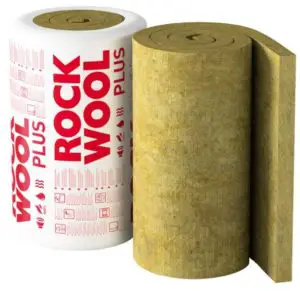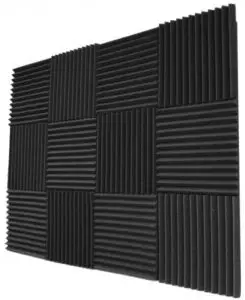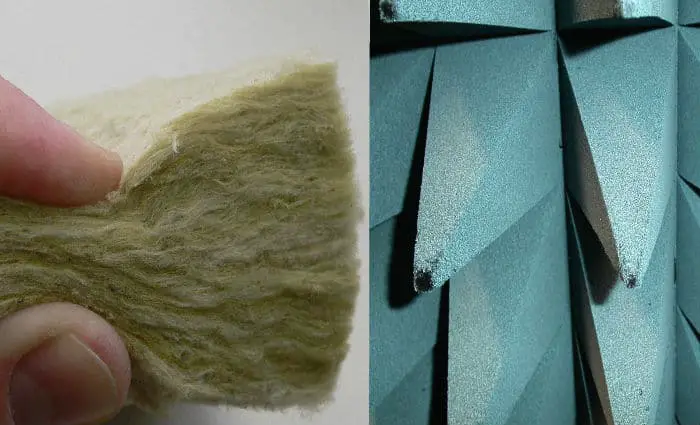Have you ever been in a situation where you had to choose between rockwool and acoustic foam? I know I’ve been there, and it was very hard to pick one because I was uninformed.
That is why, in this article, I’m going to explain to you everything you need to know about both of them.
The thing is, neither rockwool or acoustic foam is better than the other. It all depends on what you want out of your room treatment.
But, let’s not jump to conclusions yet, because I will describe them. Then you can choose your most useful one depending on your situation.
Rockwool: proprieties, characteristics, specs

Rockwool is a non-combustible, lightweight product that has some excellent acoustical-dampening proprieties.
It also is dimensionally stable, so it makes it ideal for a friction fit in wall, ceiling, and floor applications. Another interesting fact about it is that the rockwool is chemically inert, that’s why it won’t promote corrosion.
Because of its compounds and weight, it is really easy to cut. The cutting will not require any special tools.
You can even use a knife if you are careful enough. However, you will need to cut it because it usually comes in thick pieces when bought.
Rockwool even comes at a budget-friendly price, but, unfortunately, the design isn’t that pretty.
However, you can solve this problem easily. Just make sure you cover it, so it looks acceptable. It is up to you what cover-up material you are going to choose, but my suggestion is to not look at any fancy material unless your budget is high.
However, the design is subjective, so it’s your call.
Additionally, rockwool has a characteristic that many people find crucial. If you want to soundproof a room, rockwool can absorb bass or anything in the lower region.
If any of your treble is below 1kHz, this product will surprise you in a good way. It comes in different thicknesses, so it will be effective in a lot of scenarios.
Characteristics & specs
If you are still confused about it, I’m going to list 9 characteristics of rockwool:
- It has a high thermal efficiency. This means that once you cover a whole room in rockwool, it will save you money. ‘How is that possible.’ you may ask. It’s very simple. Because of that property, the room will be much warmer and stay that way for a long time in the winter. Your energy bills will be lower, and, therefore, you are saving money.
- The main reason why someone would install this is, of course, is because of the noise insulation it offers. It has a high density that traps sound waves and deadens vibration time. Moreover, it can block sound frequencies lower than 1kHz, as I’ve already told you.
- It is made from a material that is fire-resistant, so you will feel safer in your own home. However, you should not rely on that, as it is combustible. In case of a big fire, it will burn.
- It is a breathable material. Many people are scared that installing rockwool on your wall is going to allow it to grow bacteria. That is very wrong. This material will allow moisture to escape from the construction, so you don’t have to worry about that.
- It constitutes a compression-resistant material that can be used as roofing boards or bonded panels.
- It’s quick and easy to install.
- It offers a healthier environment wherever installed because it improves the thermal comfort and air quality.
- Rockwool has an unlimited lifetime, so you don’t have to check or change it at all. It is a worth long living investment.
- It reduces carbon footprint, so it has a minimal environmental impact.
Acoustic foam: properties, characteristics, specs

Acoustic foam is an open-celled foam used frequently for acoustic treatments. The principle behind it is to accentuate airborne sound waves by increasing air resistance.
This procedure will usually reverb and flutter echoes as well. The result is the reduced amplitude of the sound waves. The energy is dissipated as heat.
It is a lightweight material made from polyurethane foam from either polyether or polyester.
They are easy to recognize as most of them have a special cut.
They are cut into tiles, often with pyramid or wedge shapes. This cut allows them to be effective in terms of soundproofing, while also improving the sound quality of the room.
Just like the rockwool, you can pretty much place them anywhere, including walls, the ceiling, or even doors. Some of the acoustic foam products only require you to stick them wherever you planned.
To stick, just unpeel the backing and stick where you want it. They come in little pieces, so you need to do that for each of them: very easy to install.
The design is great as well. It’s subtle and good looking. They come in several different colors, so you can match them with where you want them to be installed. They are sold in different thicknesses as well.
However, you should watch out for this characteristic when buying. When soundproofing a place, the thickness of the acoustic foam is not as important as its density. Make sure you first look at that.
Rockwool has a lot of the characteristics of rockwool, so rewriting them isn’t necessary.
Usages of Rockwool and acoustic foam
Although they may seem like normal soundproof materials, they can do more than that. They can be used for secondary uses such as:
- You can use them to improve the fire protection in the house.
- You can use them in order to create a studio.
- You can install them if you have a band, and you don’t want to upset your neighbors.
- They are also used for better heating in a room, etc.
However, as their main purpose is soundproofing, don’t use them just for these uses.
Rockwool vs Acoustic foam
Overall, my recommendation is rockwool. It is cheaper and more efficient, as it can block lower sounds as well. It also comes in thicker pieces, so it can absorb more sound.
On the other hand, acoustic foam has a much better design that can make your room look very professional. You will see this in most of the popular sound recording studios.
As a funny fact, you can even grow plants inside rockwool.
An important factor is to keep placement in mind for both of the materials here. I told you that rockwool is more efficient, but, placed in random places, it can do less work than acoustic foam placed in key locations.
People will have different preferences, so I’m going to recommend the best products for both of them.
Recommendations
Rockwool products are different, depending on where and how you want to install it. That is why I’m going to recommend you the https://www.rockwool.com website. You can browse there and choose the “want” section. You can also find them on Amazon.
It will suggest products for either wood interior, steel interior, party, or multipurpose wall insulation. If you don’t want wall insulation, they have a special set of questions that will make sure you are going to get the best products.
They pretty much offer you everything, including a DIY installation of rockwool. People are very happy as well according to reviews, so I recommend giving it a try.
As for acoustic foam, my suggestion is the Auralex Acoustics SonoFlat. Auralex is one of the most popular brands that produce acoustic foam products. This one, in particular, comes in 3 different colors and offers a good value for the price. It has a high density, absorbing mid to high-frequency reflections to control the ambiance of any room.
Moreover, it alleviates flutter echo and slap back, being resistant and not deteriorating or crumble apart over time.
The composition of it is interesting and environmentally friendly, as it is formulated out of soy components. They don’t have any pyramid shape, but they still absorb a good amount of noise.
All of those for about $90 per 14 panels, quickly delivered by Amazon. Clients seem to be overall happy, as it has a 3.7-star review. The link to it here.
How to install rockwool
Here is a visual guide:
I told you everything about it, even where to buy it, but now here comes the most important part. After you buy it, you need to install it of course. My advice is to use a material called a Cascadia clip.
It will make your life easier. It is a fiberglass spacer designed to support vertical or horizontal girts. You will need rockwool, steel poles, a knife, ta ape measure, Cascadia clips, and stick pins. So let’s get to work.
Step 1.
Always take your measurements first. After you planned everything in your head, mark it in order to be more precise. It is important to start at the inside and outside corners and work from there.
Step 2.
Attach the Cascadia clips. You will want them about 24 inches from the center.
Step 3.
Install the metal girts, making sure that the fasteners penetrate all the way through and into the steel studs.
Step 4.
Install the insulation retention system but make sure you use the temporary stick pins to make your job easier.
Step 5.
Install the insulation by fitting one side of the rockwool behind the unfastened leg, then do the same with the other side. There shouldn’t be any void or gaps in the insulation if you installed it correctly.
That was it for the vertical installation. If you want to install it horizontally, change the Cascadia clips position and make sure you cut the rockwool so it fits snug between the steel poles.
How to install acoustic foam
Here is a visual guide:
Depending on the type of acoustic foam, you may only need just to unstick the material on the back and place them wherever you like. However, I’m still going to explain how to install those that do not come with such a simple system.
However, acoustic foam is easier to install then rockwool, so don’t be too pessimistic. It shouldn’t take you more than 1 or 2 hours, depending on the area you want to cover.
First, get the materials. You are going to need acoustic foam, a tape measure, cardboard sheets, a handsaw, an electric carving knife, a foam tack or a tube tack, tacks and tack hammer, safety goggles, and a dust mask.
Step 1.
Take measurements of the part of the room that you want to insulate. You don’t need to cover all of it, but you need to place the acoustic foam in the key parts of your specific room.
Step 2.
Cut the cardboard with the hand saw into pieces that are the exact size as the acoustic foam panels. You may wonder why I told you to use this material. If you do want to remove the acoustic foam, it will not damage your wall if you place them on the cardboard pieces.
Step 3.
Attach the foam to the panel if they are the same size. Use either the foam tack or the tube tack to do that.
Step 4.
Using the tack hammer, nail the panels to the parts of your room. Start at the corner of each wall, and, if a piece is too big to fit when finishing, use the electric carving knife to cut the panels accordingly. Always wear both safety goggles and the dusk mask during this process.
Conclusion
No matter which design you prefer the most, both of these materials will satisfy you in certain situations. If we are talking about blocking some low frequency sounds, go with the rockwool.
If you want to soundproof a room in order to use it as a studio, go with the acoustic foam, as you may like the room to be nicer in terms of design. What material did you choose for this and why? Are you satisfied with your project?
